The application deadline for Montana big game, elk, and deer combination licenses, along with deer and elk permits, is April 1, 2024, by 11:45 p.m. MT. The application process is completely online here or in any Montana Fish, Wildlife and Parks (FWP) office.
New Or Noteworthy For This Year
Hunt districts 410 and 417 are now draw only. No general hunting for mule deer is allowed in these units.
The state is shortening the length of mule deer seasons in some select hunting districts. Be sure to pay close attention to the regulations for the area you will be hunting.
If you apply for a nonresident combination license and do not purchase a preference point at the time of applying you will be unable to do so later during the points only purchase period.
Applicants must draw a nonresident combination license before their limited entry permit application is considered.
Applicants who draw a nonresident combination license can hunt any rifle or archery season available in any general unit for the species specified on the license.
Preference and bonus points purchased at the time of application are applied to the current year’s application.
Insider Features
HUNT PLANNER
To aid in your research and planning efforts, we created a brand new tool for Insiders called Hunt Planner. This tool will help you be more efficient at planning for hunts and also keeps all your research data organized. No more notepads getting lost or headaches when trying to remember what units caught your eye during your research! Everything you need is always in one place at GOHUNT.
What can you do in Hunt Planner?
Save unit seasons in Filtering.
Never lose track of units you want to further research.
Rank seasons.
Decide what unit to apply for or what order to place your units when applying on a state's website.
Compare seasons (up to three at a time).
Save the filter settings you used in Filtering to find a great hunt.
Add notes to your research folder under season level or hunt folder level.
And much more!
POINT TRACKER
Point Tracker allows you to enter the number of points you have for each state and species and, as you research through Filtering and Draw Odds, your point total will automatically be highlighted.
State Information
View important information and an overview of the Montana rules/regulations, the draw system and bonus points, SuperTags, tag and license fees and an interactive boundary line map on our State Profile. You can also view the Montana Mule Deer Profile to access historical and statistical data to help you find trophy areas.
IMPORTANT DATES AND INFORMATION
Applications for deer must be submitted by 11:45 p.m. MT on April 1.
Applications can be submitted online here after March 1, 2024.
An 80% refund can be requested on nonresident licenses if requested by Aug. 1, 2024.
A 50% refund can be requested on nonresident licenses if requested after Aug. 1, 2024.
Draw results will be available approximately two weeks after the draw deadline.
Surplus licenses are available for purchase in early August.
Preference and bonus points are available for purchase for nonresidents who did not apply in the general drawing for a fee. See more information here.
Bonus points purchase period: July 1 to Sept. 30.
Preference point purchase period: July 1 to Dec. 31.
Montana license, point, and permit fees
Item |
Resident fee |
Nonresident fee |
Base hunting license |
$10 |
$15 |
Conservation license |
$8 |
$10 |
Deer license |
$16 |
n/a |
Elk license |
$20 |
n/a |
Deer combination license |
n/a |
$724 |
Elk combination license |
n/a |
$1,048 |
Big game combination license |
n/a |
$1,242 |
Deer permit application fee |
$5 |
$5 |
Elk permit application fee |
$9 |
$9 |
Bonus point fee (with draw application) |
$2 |
$20 |
Bonus point fee (points only period) |
$15 |
$25 |
Preference point fee |
n/a |
$100 |
Item | Resident fee | Nonresident fee |
Base hunting license | $10 | $15 |
Conservation license | $8 | $10 |
Deer license | $16 | n/a |
Elk license | $20 | n/a |
Deer combination license | n/a | $724 |
Elk combination license | n/a | $1,048 |
Big game combination license | n/a | $1,242 |
Deer permit application fee | $5 | $5 |
Elk permit application fee | $9 | $9 |
Bonus point fee (with draw application) | $2 | $20 |
Bonus point fee (points only period) | $15 | $25 |
Preference point fee | n/a | $100 |
PREDATORS IN MONTANA
The predator populations in Montana are often the subject of spirited debates with strong feelings on both sides of the spectrum. Wolf packs continue to maintain healthy population levels and have firmly rooted themselves into most of the western portion of the state. Deer and elk populations are down throughout the state compared to historic levels, but great hunting can still be found.
Grizzly populations continue to climb along with bear and hunter interactions. Currently, hunting seasons across the West are still on hold for grizzly bears. Much of western Montana is home to a roaming population of grizzlies and hunters need to be acutely aware and prepared when spending time in these locations.
Even with growing grizzly concerns, hunters can still find plenty of huntable areas where they won’t have to worry about grizzlies. When researching specific areas, a quick call to local biologists can be well warranted.
Current snowpack conditions
The 2023/2024 winter has been fairly normal for Montana and most of the state is hovering around average for snowfall. Winterkill should be mostly minimal this year, but the main attention will be turning to available feed on the landscape throughout the spring months. Rains will be vital throughout the spring and early summer months and will be something to keep an eye on. However, 2024 should be a great year to have a tag.
2024
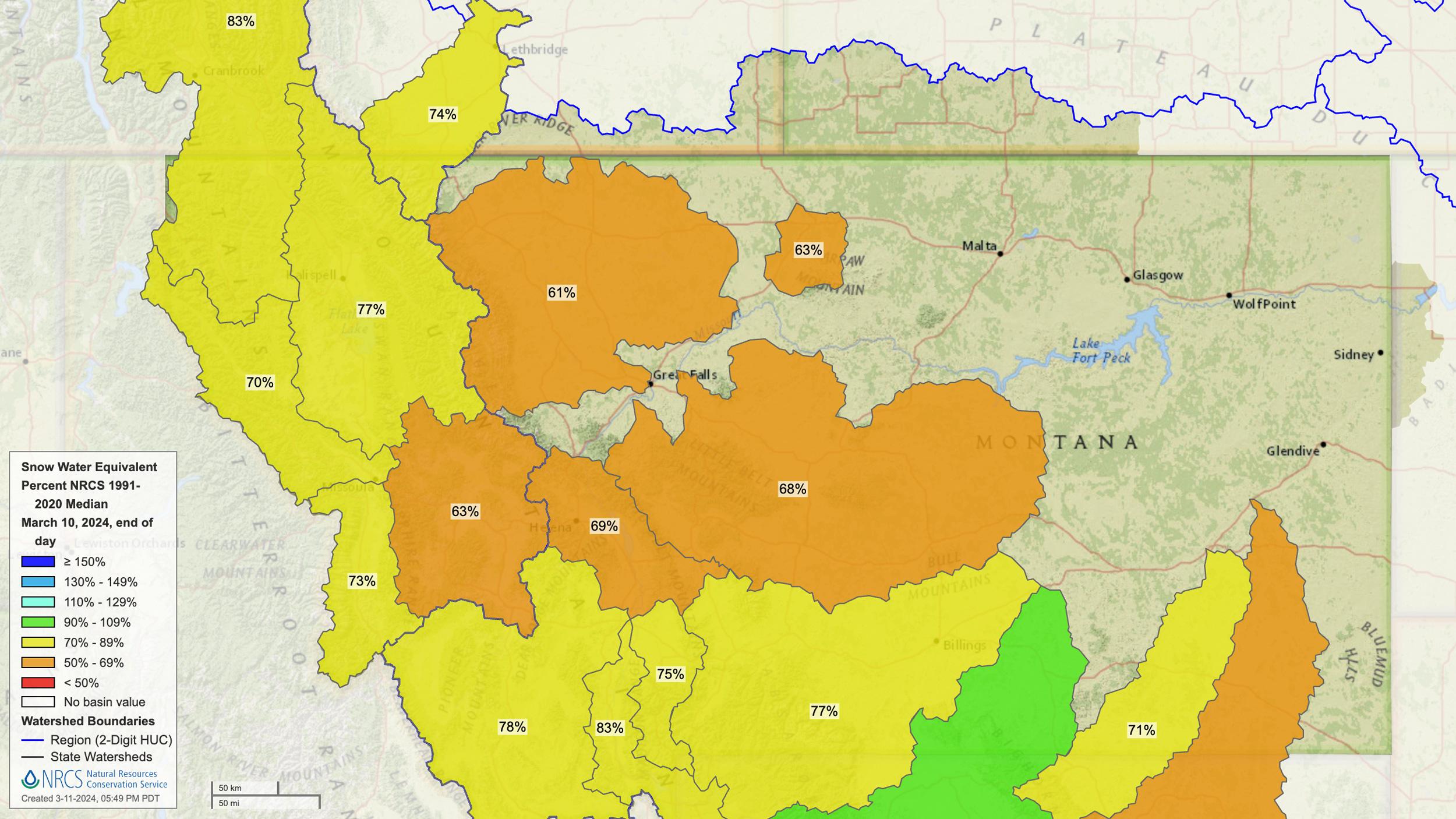
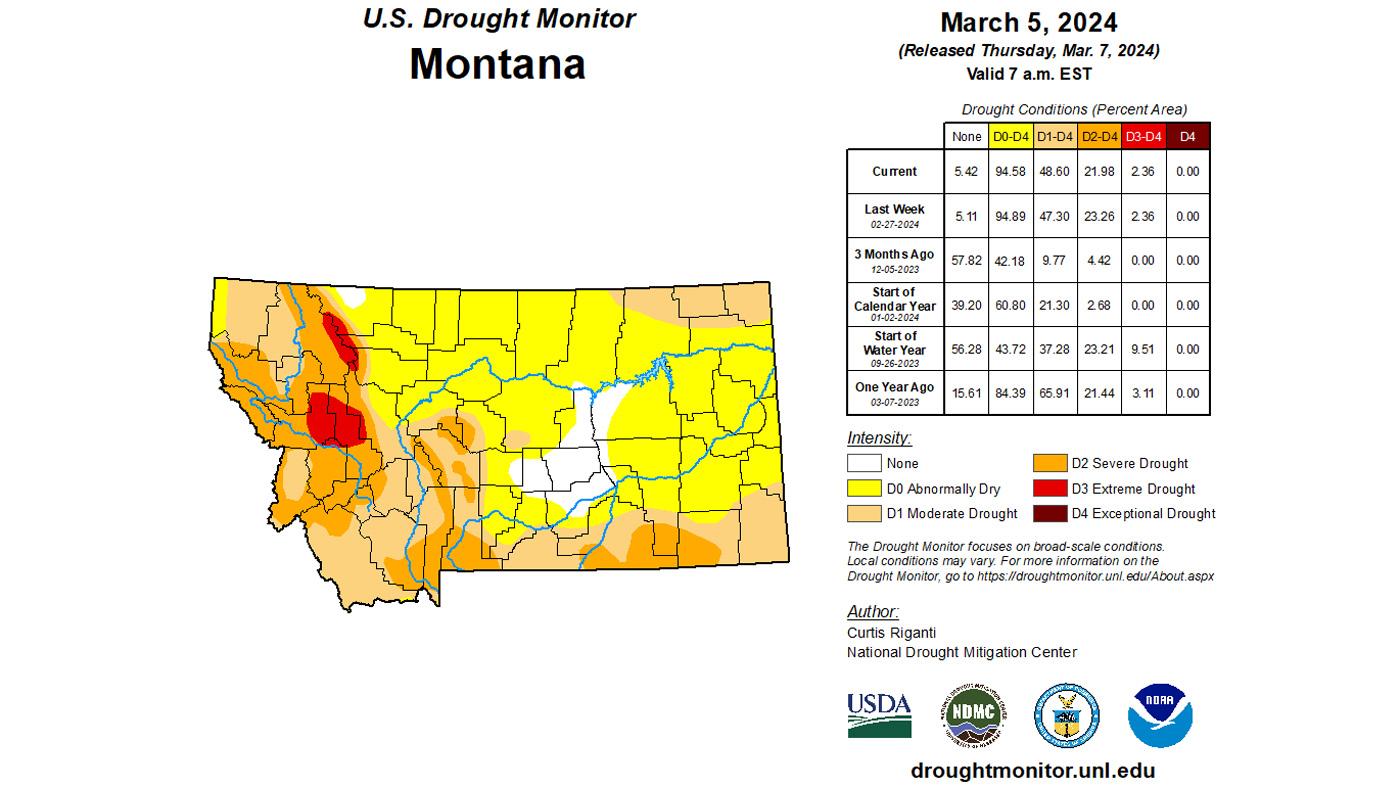
2023

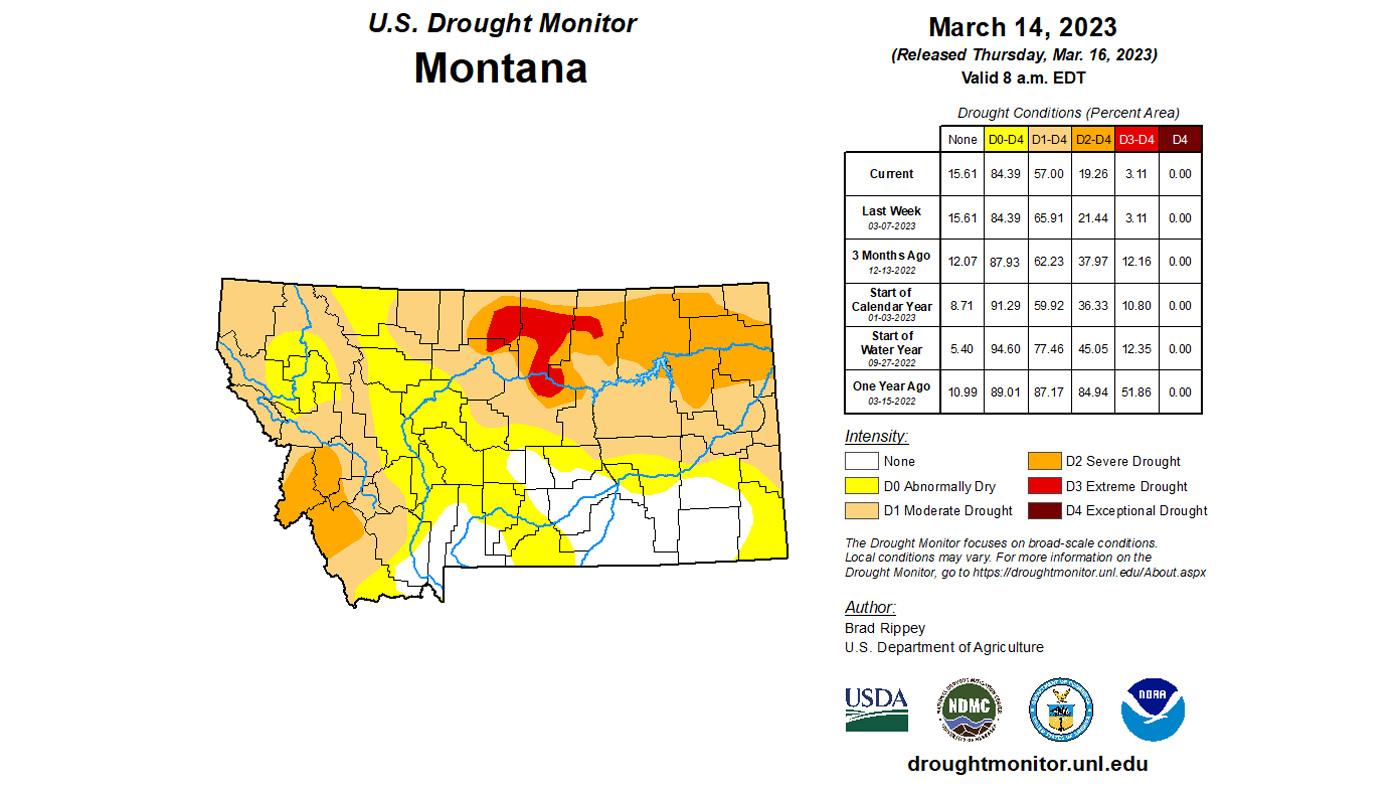
2022
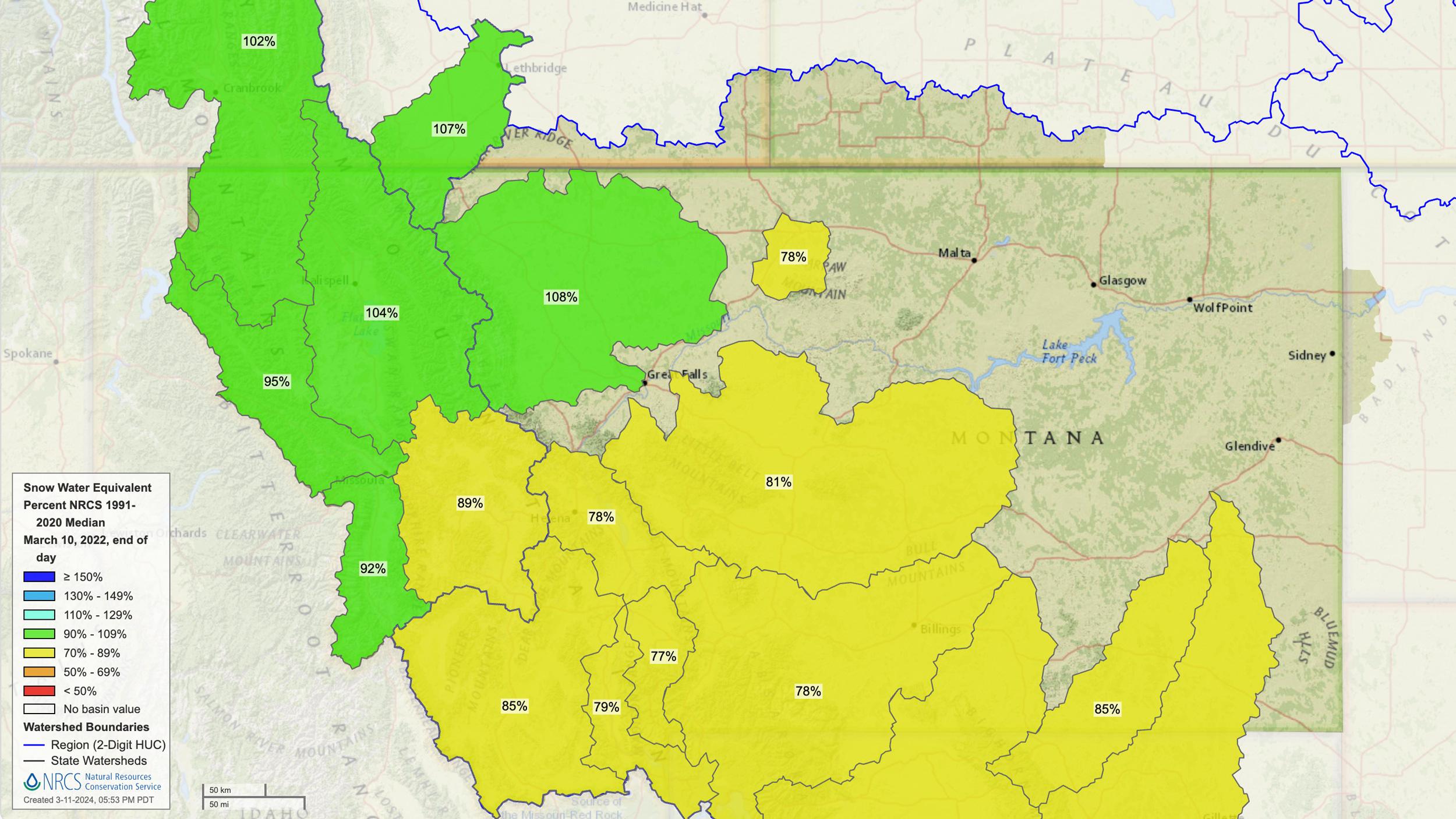
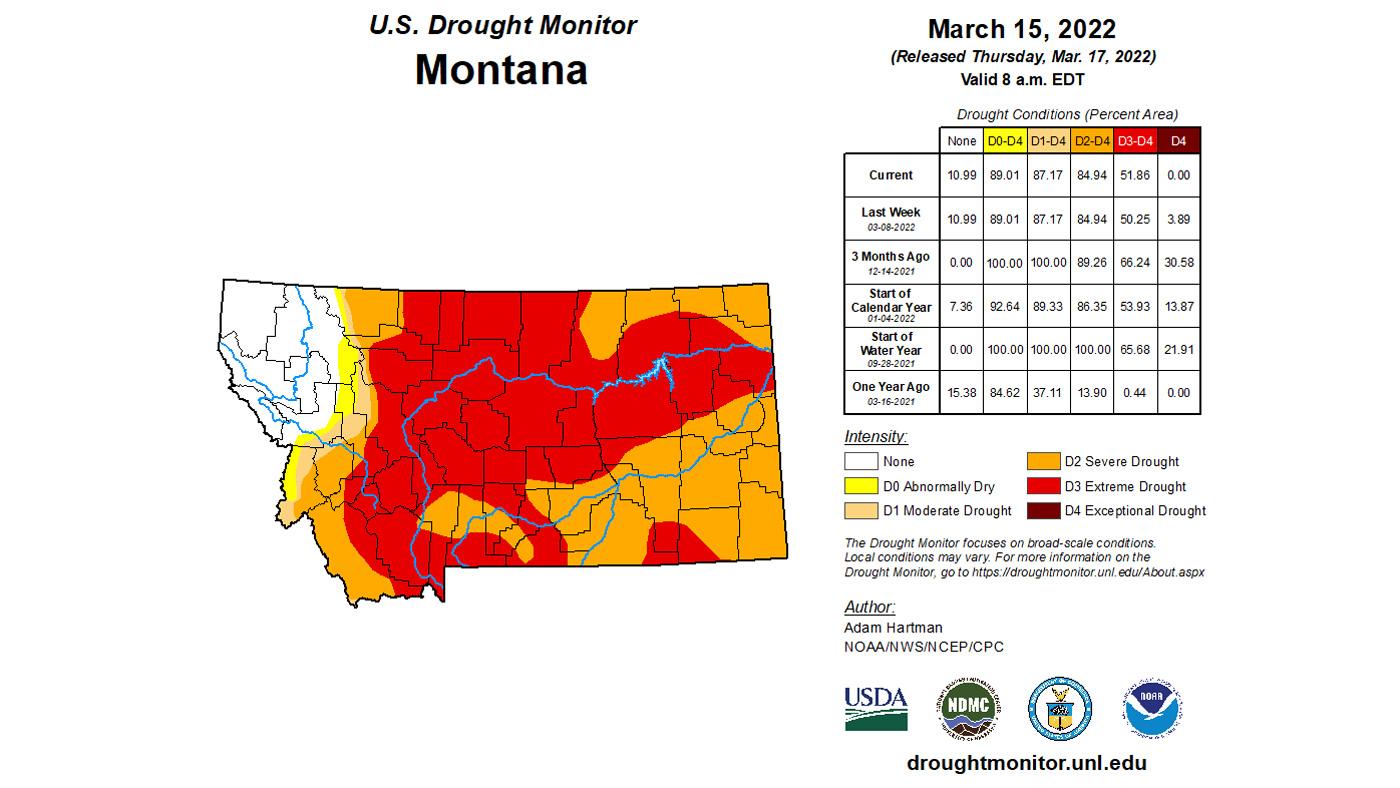
2021
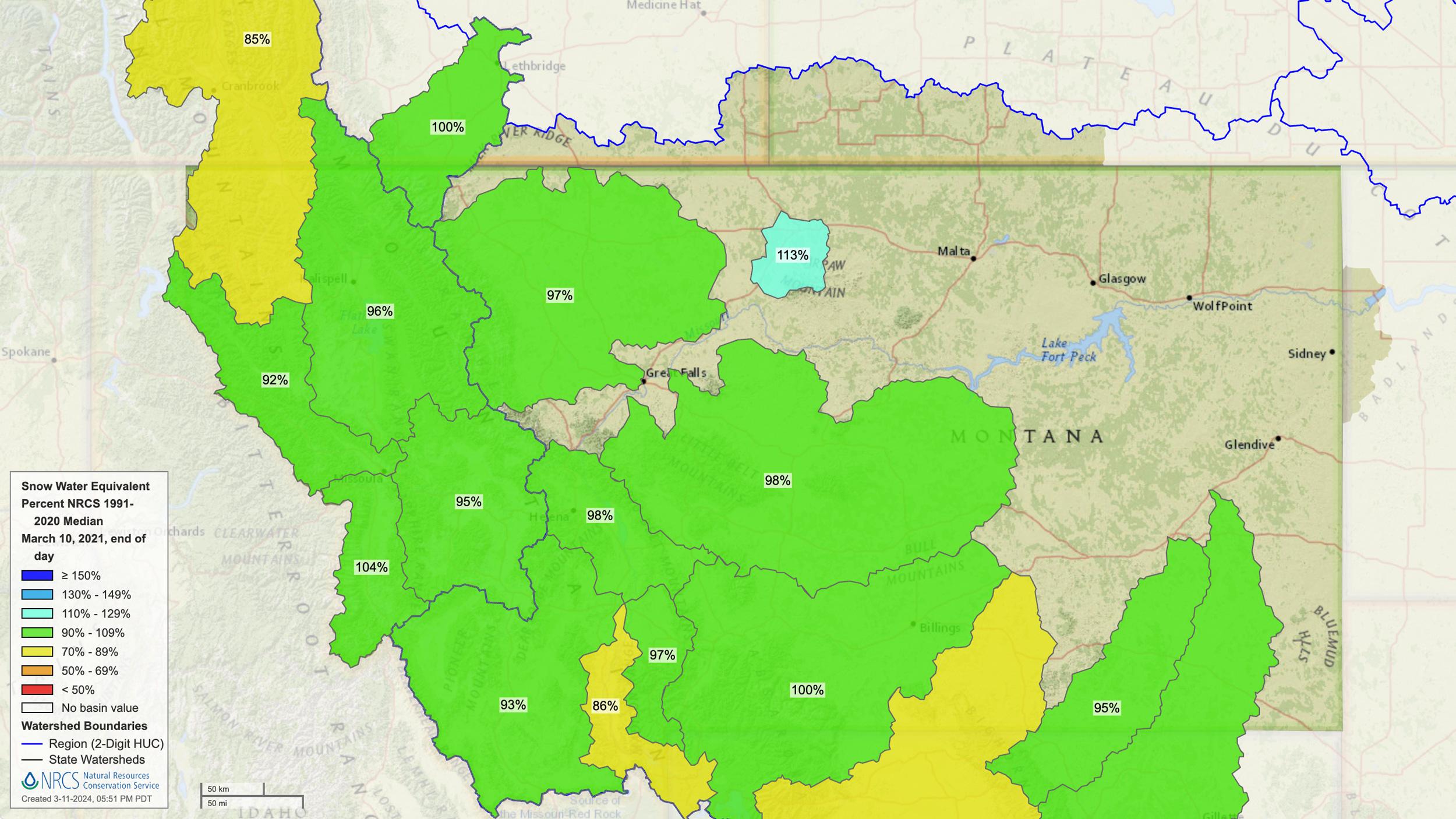
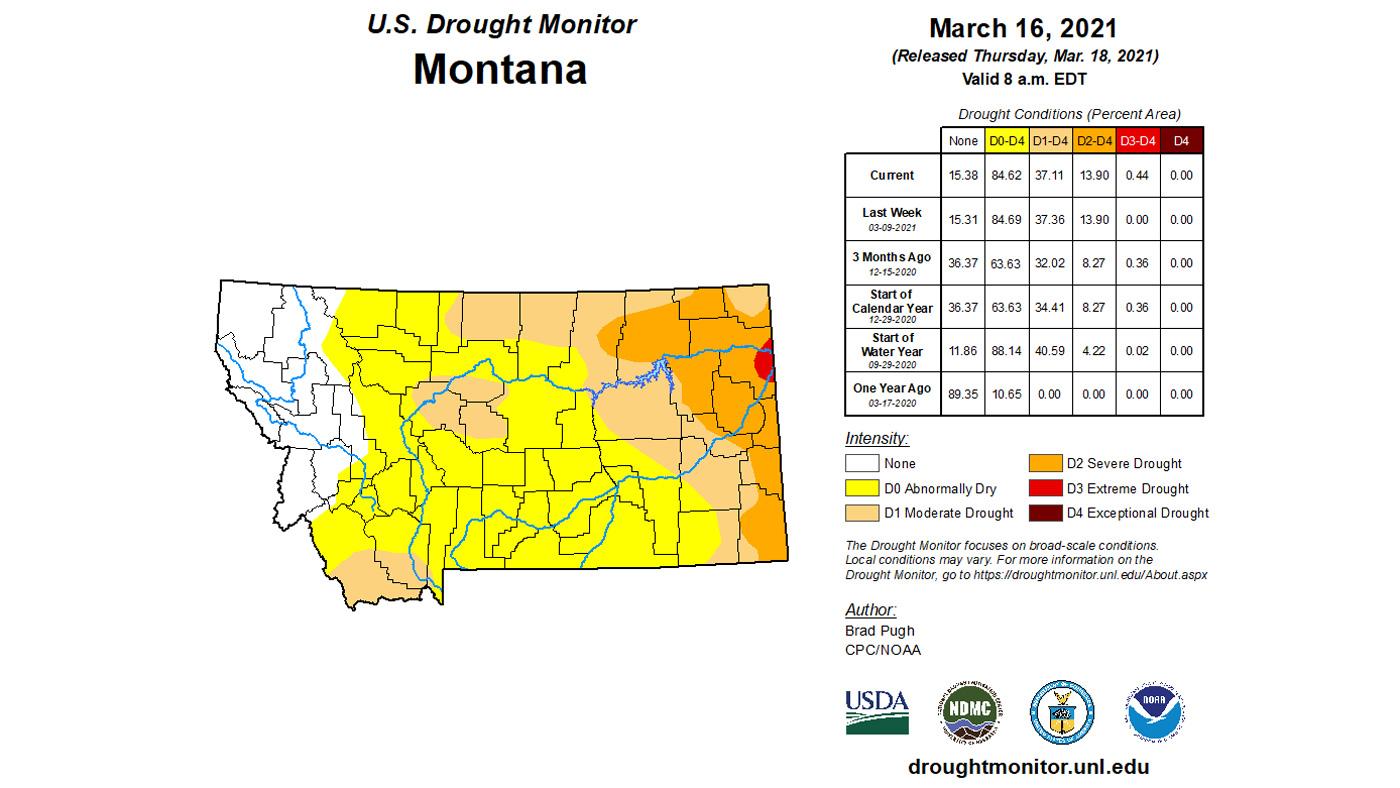
The Montana Draw System
Before diving into the trending hunt districts for Montana mule deer in 2024, it is first important for hopeful applicants to fully understand the Montana draw system, which can, at times, be very complicated. For the main limited entry permit draws, Montana employs a random lottery that is weighted by bonus points. Additionally, bonus points are squared at every point level. This system heavily favors those with the most points; however, every applicant at every point level has a chance of drawing a tag every year. The bottom line: you’ll never draw if you never apply.
MONTANA NONRESIDENT BIG GAME COMBINATION LICENSES EXPLAINED
The prerequisite for all nonresidents in Montana will be the big game, elk or deer combination license.
Elk combination license: elk, conservation license, state lands, upland bird (excluding turkey), base hunting, aquatic invasive species prevention pass (AISPP) and season fishing license.
Deer combination license: deer, conservation, state lands, upland bird (excluding turkey), base hunting, AISPP and season fishing license.
Big game combination license: deer, elk, conservation license, state lands, upland bird (excluding turkey), base hunting, AISPP and season fishing license.
The combination licenses essentially act as a general tag for Montana and must be drawn. Unlike limited entry permits, the combination licenses are distributed through a preference point system where 75% of the tags are reserved for the highest point holders. The remaining 25% of the tags are then put into a random draw with the remaining applicants who have not purchased any preference points.
NONRESIDENT TAG ALLOCATION
Montana grants nonresidents up to 10% of a district’s tag quota; however, the 10% is not guaranteed. Some years, the nonresident applicant pool will fill the entire 10% cap and other years it can be significantly less.
LIMITED ENTRY PERMITS
Beyond the general tags and nonresident combinations, hunters can apply for limited entry permits. Successfully drawing a limited entry permit does not grant a second animal, but does augment the general tag to include new areas for hunters. These limited entry districts generally carry higher success rates and more mature animals, but this is not always the case. FWP also uses some limited entry districts as population control tools where they offer unlimited permits in hopes that the area will see a higher harvest for the year. Out of all of the limited entry districts for deer and elk, less than half actually offer better odds at trophy animals than some of the better general hunts.
PARTY APPLICATIONS
In addition to individual applications, hunters can also apply for deer and elk permits and/or nonresident combination licenses as a party. The maximum party size is five. When processing a party permit, the state will consider the average number of points between all of the party members and then round to the nearest whole number for a final party permit total. For example, a party with an average of 2.33 points would enter the draw at two points while a party with 2.66 points would enter at three. When it comes to nonresident combination licenses and preference points, the state looks at party applications somewhat differently. With the preference points, the group goes into the draw with the exact average of points for the group. As an example, if a group of three applicants averages 1.66 points, then the group will apply at exactly 1.66 points.
When used correctly, party applications can be very beneficial. Residents and nonresidents can apply jointly, but the party will be forced into the 10% nonresident pool for available permits.
POINTS ONLY OPTION
If applicants are simply looking to build points for the current year—both preference and bonus — they can skip the expensive application prerequisites. Bonus points can be purchased between July 1 and Sept. 30 for $15 per species for residents and $25 for nonresidents. Additionally, nonresidents can purchase combination license preference points from July 1 to Dec. 31 for $100. You cannot apply for a permit or combination license and purchase a separate point in the same year. Only one point per species can be accumulated per year.
In 2022, FWP established a new rule that allows applicants hunting with an outfitter to purchase up to two preference points when applying. These points can be purchased for $100 each. Licenses issued using this point perk are only valid for hunting with an outfitter.
A TIP FOR PREFERENCE AND BONUS POINTS
Montana offers applicants a unique opportunity to purchase preference points prior to the draw deadline for use in the current year application on nonresident combos and limited entry permits.
Point purging
And lastly, as icing on the cake, the state will also purge your accrued preference point each year. As an example, if you earn a point in 2024 but do not apply in 2025 the state will take the point from you.
A popular tactic here would be to purchase a point the year before you want to hunt and then purchase another at the time of application for a total of 2.
THE DIFFERENCE BETWEEN BONUS AND PREFERENCE POINTS
Every year, we get many questions regarding the difference between the two point types in Montana and how they both work.
Bonus points: Montana has a bonus point system in place for all special permits (deer, elk, antelope, bighorn sheep, moose and mountain goat). Every year that you are unsuccessful in the drawing — and you participate in the bonus point system — you will be awarded a point. When you apply in the draw, your accrued points are squared to increase the odds exponentially for the applicants with more accrued points. All base bonus points accumulate over time until you draw a permit.
Preference points: Montana also has a preference point system for nonresident big game combination, elk combination and deer combination licenses. Preference points increase the chances of drawing a combination license and, essentially, move you ahead in line. 75% of all combination licenses awarded during the draw will be issued to hunters with preference points. Anyone applying with three preference points will draw the license before anyone with two and so on. Preference points accumulated will be used during the current drawing whether you purchase an additional preference point or not.
Montana's Deer Breakdown
Montana is a great state to consider for your next mule deer trip, but some understanding of the state should be considered before planning your adventure. In general, populations of mule deer are higher in the eastern half of the state, but this will also draw larger crowds. The western populations have dipped in recent years and quality hunting can be tough to find. In general, Montana is not a big buck state. Now, I know the term “big” is subjective, but as a general rule of thumb, 170”+ bucks are not common and 180”+ are rare for the general units. Through hard hunting, hunters can expect opportunities at bucks in the 150” to 160” range on the big end. What Montana lacks in trophy quality, it makes up for in deer numbers in some areas. In good units in the state, hunters can expect to see many deer each day and have good opportunities to punch a tag on a mature buck. On the flip side, there are also units where a hunter may hunt for days and only see a few deer. Montana is a massive, massive state and doing your research prior to the hunt will be important to maximize what you get out of your tag!
Region by region Montana mule deer buck harvest
Area |
Bucks killed* |
Region 1 |
1,011 |
Region 2 |
1,438 |
Region 3 |
5,700 |
Region 4 |
7,437 |
Region 5 |
3,417 |
Region 6 |
7,237 |
Region 7 |
7,030 |
Area | Bucks killed* |
Region 1 | 1,011 |
Region 2 | 1,438 |
Region 3 | 5,700 |
Region 4 | 7,437 |
Region 5 | 3,417 |
Region 6 | 7,237 |
Region 7 | 7,030 |
*2022 data. As of March 13, 2024, the 2023 data has not been made available.
Current mule deer herd condition
Winterkill rates have been fairly normal over the last few years; however, populations continue to drop in many areas across the western half of the state. In response, FWP has decided to end general mule deer seasons by mid-November in several units in the western half of the state. This shortened season should cut some of the mule deer harvest success of mature bucks in general although hunters could still have some heavy rutting activity, depending on the weather. Deer on the eastern side of the state have been hit fairly hard with drought conditions over the past few years and populations and mature buck densities have taken a hit. Good hunting can still be found in these areas, but many reports are indicating that hunting conditions have gotten a lot tougher.
Trophy potential is not great in Montana; however, hunters do occasionally stumble into some large deer. In general, bucks exceeding the 160” Boone & Crockett (B&C) mark are among the top-tier deer for any given unit with the average bucks falling around 140” to 150”. Some of the units in the eastern portion of the state have been known for producing bucks over 180”, but hunters will need to work extremely hard or secure private access for these. Some of the more prolific limited entry units have been routinely producing bucks well above the B&C minimum; however, hunters will face incredibly steep odds in securing a tag.
As stated, private lands throughout the state — particularly those in the east — will provide the best opportunity at trophy class bucks. Fortunately, there is so much public land available in the state that hunters can really find good bucks anywhere with enough work and boot leather.
Hunt choices
GENERAL SEASON
The general season units are where the vast majority of hunters will find themselves year after year. The biggest bucks are routinely taken on limited entry hunts, but hunters can find some great hunting in the general areas. Trophy potentials will generally be lower; however, those who invest the time into research and hunting will find good repeatable success in a slew of units across the state.
General season hunts are available as over-the-counter (OTC) for residents, but must be drawn by nonresidents through the deer combination or big game combination license. Different parts of the state will require different tactics and those who are flexible in their approach can find plenty of lightly pressured animals away from the crowds. With the wide array of terrain types offered in the state, hunters should have little trouble putting together a hunt to meet all of their needs.
After drawing a general tag, a license holder can hunt deer in any of the general units and can hunt both the available archery and rifle seasons.
Montana's top general deer hunting districts by number of mule deer bucks harvested
Hunt district |
Trophy potential |
Bucks harvested |
4 point percentage |
670 |
150”+ |
1550 |
76% |
704 |
170”+ |
1450 |
88% |
705 |
170”+ |
1382 |
69% |
703 |
160”+ |
1256 |
73% |
690 |
160”+ |
1221 |
78% |
640 |
150”+ |
1214 |
76% |
701 |
170”+ |
1081 |
70% |
700 |
160”+ |
1002 |
73% |
323 |
150”+ |
996 |
50% |
590 |
160”+ |
797 |
63% |
Hunt district | Trophy potential | Bucks harvested | 4 point percentage |
670 | 150”+ | 1550 | 76% |
704 | 170”+ | 1450 | 88% |
705 | 170”+ | 1382 | 69% |
703 | 160”+ | 1256 | 73% |
690 | 160”+ | 1221 | 78% |
640 | 150”+ | 1214 | 76% |
701 | 170”+ | 1081 | 70% |
700 | 160”+ | 1002 | 73% |
323 | 150”+ | 996 | 50% |
590 | 160”+ | 797 | 63% |
Due to Montana’s harvest data collection practices, it can be very difficult to find good usable data when researching hunts. One aspect I like to look at is the number of bucks harvested. A high number of bucks harvested can mean a large number of things; however, if I was primarily interested in taking any legal buck, I know that this will provide a good starting spot. Additionally, I also like to compare these numbers with public land percentages as this will really start thinning out the list for me.
Many of the above listed units are found on the eastern half of the state and also include a much healthier distribution of private lands than those found to the west. However, it is important to keep in mind that the sheer size of most of these units can double or even triple other units in the state and there are still thousands of acres of public land to be hunted. Land ownership tends to be very checkerboarded in these areas and knowing the public/private boundaries will be pivotal.
The above list is also more geared towards a hunter who is purely heading to Montana to hunt deer. Keep in mind that if you’re actually doing a combo hunt for elk, you may be looking into different areas.
BLOCK MANAGEMENT AREAS (BMA)
Along with the great public land options, hunters will also find cool opportunities to hunt private land through Montana’s Block Management Program. Under this program, private landowners enroll their parcels of land with FWP to allow access for hunting in return for a monetary payment. This can be a great program for hunters to take advantage of and can certainly play into your application strategy in some areas. You can read more on this great program here.
LIMITED ENTRY
Like many other western states, the biggest bucks in Montana are often the product of a limited entry hunt. It is important to realize, though, that not all limited entry hunts will equate to better deer hunting. Some are used in areas where hunter numbers need to be controlled due to low deer numbers and others are used where FWP wants to reduce deer numbers.
In general, when targeting the largest bucks in the state, only a handful of units will truly offer hunters a unique hunting opportunity. This small selection of quality units forces long-time applicants into the same hunts year after year. Without a true preference point system for permits, you are playing the odds game every year — no matter your point level.
All things considered, applying for permits is cheap if you are already planning on hunting with the general tag so throwing your name in the hat is a no-brainer.
GOHUNT hit list for limited entry mule deer hunts in Montana (not in order of quality)
Hunt district |
Trophy potential |
4 point or better percentage |
Bucks harvested |
261 |
180”+ |
67% |
9 |
262 |
180”+ |
65% |
20 |
270 |
180”+ |
78% |
54 |
130 |
170”+ |
77% |
26 |
291 |
170”+ |
72% |
39 |
303 |
170”+ |
53% |
34 |
401 |
170”+ |
62% |
365 |
441 |
170”+ |
80% |
64 |
652 |
170”+ |
65% |
81 |
Hunt district | Trophy potential | 4 point or better percentage | Bucks harvested |
261 | 180”+ | 67% | 9 |
262 | 180”+ | 65% | 20 |
270 | 180”+ | 78% | 54 |
130 | 170”+ | 77% | 26 |
291 | 170”+ | 72% | 39 |
303 | 170”+ | 53% | 34 |
401 | 170”+ | 62% | 365 |
441 | 170”+ | 80% | 64 |
652 | 170”+ | 65% | 81 |
HD 261 and 262: Both of these units are currently among the most popular for big bucks in the state right now. Bucks eclipsing the 190” mark have been common for the last several years with a decent handful approaching the 200” line. HD 261 is comprised of more public land than 262, but nearly all of the big deer will be killed on private lands. Beyond drawing the tag, the biggest hurdle in this hunt is simply gaining permission to hunt a piece of land that is holding a big buck. Hunters interested in trophy deer will enjoy this hunt; those who are also after the adventure will not.
HD 270: Still one of the most popular hunts in the state, HD 270 has long been known for producing some incredible deer. Trophy size has been down in the past few years, but hunters can still expect realistic shots at bucks above the 180” mark. The area is comprised of a healthy mixture of private and public lands with good bucks found on both. Anyone who draws this permit will be in for an incredible hunt. There is a new permit for HD 270 for this season that will limit hunters to bucks with three points or less. There is a large 3-point gene currently existing here, along with some giant 2-point bucks.
HD 130: HD 130 is located in the western half of the state within the Mission Mountain Wilderness Area. This unit is very rugged and hunters will need to work extremely hard. Deer populations are stable, but locating buck bucks can take some effort. Grizzlies are very dense in this unit.
HD 291: HD 291 has been a somewhat undercover big buck unit for a number of years. Trophy potential is decent, but some incredible deer have been taken on private ranches in recent years. Hunters will find a small distribution of public lands although these areas do carry a lot of deer and some good bucks.
HD 303: This is an excellent unit to consider for those who still want a big adventure hunt. During periods of heavy snow, this unit will see a good migration of deer from the Idaho side of the border. Glassing opportunities are ample and, during the rut, this can be an incredible hunt. The average buck will land around 170”; however, with the right conditions, some staggering deer have been killed.
HD 401: This area can be hunted on a general tag; however, in order to hunt the rut, hunters will need to draw a permit. This area consists largely of private lands, but deer can grow to exceptional sizes. Hunters who secure private access will have the best odds for success and hunters who play property lines and move into small chunks of public can do extremely well.
HD 441: This unit is found along the famed Rocky Mountain Front. Hunters will find exceptional videos with good hunting opportunities. Public land distribution is fairly low in this area, but good bucks can be found. Additionally, those with the tag can hunt the 6,500-acre Theodore Roosevelt Memorial Ranch.
HD 652: HD652 is located on the eastern shores of Fort Peck Lake and offers great hunting habitat for deer. Mule deer populations are great in this unit and anyone with a tag will be in for a very fun hunt.
How to find hidden gem mule deer areas in Montana
With so many units available in Montana, the question of where to begin can be an intimidating place to start. With the wide array of terrain features available in the state, hunters can really choose a hunt that best fits their desires. Typically, those heading to the Treasure State specifically for deer will find far better opportunities in the eastern half of the state. However, hunters who are looking to make a combo hunt for deer and elk — particularly with the emphasis on elk — will find better options in the western half of the state. The most important factor to first consider will be your goals for the hunt.
Hunters shouldn’t expect a crazy high trophy potential in any unit in Montana — with the exception of some limited entry permits — however, with some research, bucks in the 150”+ range are there.
Use our Filtering tool to search historical data and find a hunt that is right for you. Utilize the trophy potential slider, public land filter and bucks harvested to really filter down the options. Keep in mind that the eastern half of the state consists of huge parcels of private lands. Some public land pieces in these areas can be completely landlocked and otherwise unavailable to hunters. Using land ownership maps can be a great way to find small access points into areas that other hunters may glaze over simply because access is difficult.
Managing Points and Expectations
PREFERENCE POINTS
Preference points are utilized when drawing for Montana’s deer, elk or big game combo licenses.
With the big changes to odds for the combination license, many people will be scrambling to figure out their application strategy. Do you apply without buying a point and hope for better odds at zero points or do you buy a point? Buying a point this year may not guarantee a tag, but it could put you in a better position for 2024. Here is a breakdown on the odds for the nonresident combos from the 2023 draw.
Montana Big Game/Elk Combination License Preference Points
Preference points |
Odds |
0 |
60% |
1 |
0% |
2 |
84% |
3 |
100% |
Preference points | Odds |
0 | 60% |
1 | 0% |
2 | 84% |
3 | 100% |
Montana Deer Combination License Preference Points
Preference points |
Odds |
0 |
54% |
1 |
40% |
2 |
100% |
3 |
100% |
Preference points | Odds |
0 | 54% |
1 | 40% |
2 | 100% |
3 | 100% |
BONUS POINTS
Montana is a state that is managed for the opportunity and, because of this, does not have the number of top quality districts as found in surrounding states. Good hunt districts are available across the state with four points or under, but the top-tier districts will require maximum points and, even then, the odds will rarely eclipse 5% even for residents.
Montana deer bonus points after the 2023 draw
Point level |
Resident |
Nonresident |
No points |
2763 |
263 |
1 |
4293 |
358 |
2 |
2714 |
263 |
3 |
2206 |
170 |
4 |
1701 |
123 |
5 |
1412 |
80 |
6 |
1091 |
73 |
7 |
1006 |
52 |
8 |
732 |
52 |
9 |
655 |
28 |
10 |
538 |
23 |
11 |
503 |
16 |
12 |
375 |
16 |
13 |
310 |
16 |
14 |
283 |
8 |
15 |
214 |
11 |
16 |
229 |
11 |
17 |
186 |
7 |
18 |
155 |
4 |
19 |
109 |
5 |
20 |
81 |
1 |
21 |
72 |
3 |
Point level | Resident | Nonresident |
No points | 2763 | 263 |
1 | 4293 | 358 |
2 | 2714 | 263 |
3 | 2206 | 170 |
4 | 1701 | 123 |
5 | 1412 | 80 |
6 | 1091 | 73 |
7 | 1006 | 52 |
8 | 732 | 52 |
9 | 655 | 28 |
10 | 538 | 23 |
11 | 503 | 16 |
12 | 375 | 16 |
13 | 310 | 16 |
14 | 283 | 8 |
15 | 214 | 11 |
16 | 229 | 11 |
17 | 186 | 7 |
18 | 155 | 4 |
19 | 109 | 5 |
20 | 81 | 1 |
21 | 72 | 3 |
Note: The above bonus point totals only include people who applied in the draw and not those who purchased points only.
I HAVE 0 DEER BONUS POINTS. WHAT CAN I EXPECT?
Before beginning your application strategy, it will be important to first decide your end goal for Montana. Mainly, do you plan on hunting Montana on general tags or are you only interested in building points to use later? As a nonresident, applicants will need to apply for their combo license in addition to any extra permits. If you are unsuccessful in the draw, you are only granted an 80% refund of your total application cost if you are not interested in hunting the general districts. If you wish to hunt other states, you can simply purchase the preference point and bonus point and move on. If you do plan on hunting the general season regardless, then put in for your district of choice. Because it’s a lottery system, there is always a chance of drawing!
At zero points, hunters will generally find their best opportunities on the general units. Basically, if you have a desired top-tier district you’d like to hunt, then your best bet is to throw your name in the hat.
WHAT CAN I DO WITH 3 TO 8 BONUS POINTS?
Hunters in this point range do have a few more options although these will still be highly limited. Nonresidents will now see a few more districts available with 100% odds, which can be an attractive use of points. These will primarily consist of units where the trophy potentials will be slightly higher than what can be found in the general units.
At this point level, both resident and nonresident applicants are within striking distance of HDs 202 and 210, although odds for some of the other remaining tags will still be under 10%. This can be a good use of points, but hunters should be aware that these are both physical hunts. Trophy potential is high, while deer densities are very low, and nothing will come easy.
WHAT CAN I EXPECT WITH 10 OR MORE DEER BONUS POINTS?
At this point level, residents and nonresidents are nearing the maximum point capacity. Applying for anything other than the top-tier districts will merely result in burning points on hunting districts that could be drawn on far less. Odds will still be steep, but your odds simply won’t improve beyond this point with Montana’s drawing system.
Applicants at this point level will generally be gunning for HD 261, 262 and 270. For a slightly better chance, HD 130, 291, 303 and 441 can also provide good opportunities for mature bucks, albeit slightly smaller in size.




